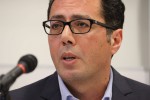Foreign aid is in danger of extinction. Can anything save it?
If, on January 19, 2025, a day before Donald Trump’s inauguration, you had asked foreign aid experts, “does the US Agency for International Development (USAID) need reform?” most would have readily said “yes.” Not enough programs are evaluated for effectiveness; too much is run through a small number of private contractors; the foreign aid mission is fragmented across too many different departments, only some of which are under USAID’s purview.
Then the monkey’s paw curled. The Trump administration has not reformed USAID so much as eviscerated it: attempting illegal mass firings, canceling thousands of aid contracts, and announcing plans to close the whole agency and fold it into the State Department. The agency got change, all right, but not at all the kind that the aid community had been requesting.
The future of the agency, and foreign aid from the US in general, remains incredibly uncertain. Federal judges have issued injunctions against the administration’s firings, spending freeze, and attempts to dissolve the agency, but the administration is sure to appeal and we are likely months away from a final resolution at the Supreme Court.
Some effects will be lasting even if the Court rules for USAID: Foreign aid groups reliant on its funding are running out of money and time, meaning that life-saving programs are on pause and many groups are on the verge of bankruptcy. But exactly how much of the Trump agenda will remain when the smoke clears is yet to be seen.
Perhaps the best way to understand where the foreign aid world is, as of late March, is through the stages of grief. The initial blitzkrieg against USAID in January had a feel of unreality: the natural reaction was denial. Once it became clear that the agency was under attack and that as a result, millions could die, the natural and correct reaction was anger.
Today, though, the dominant reaction I see in the sector is “bargaining.” No one thinks USAID or foreign aid generally are going back to where they were on January 19. While we don’t know what changes will last, it’s undeniable that some will.
The imperative that many in the sector are now feeling is not merely to push back on the administration, but to adapt to the new reality in a way that hopefully preserves the best of USAID, while making some of the reforms that experts have been demanding for years.
“We should see this as a challenge, those of us who believe in the promise of aid, to put proposals on the table,” Ken Opalo, a professor of African politics at Georgetown who has studied the effects of aid, says. “I’ve had debates with people who say, ‘Now is not the time to talk about the bad aspects of aid, because these people are not acting in good faith.’ But from a low-income country perspective, I think now is the best time to talk about that. It creates an opportunity for everyone to rethink what’s possible in the aftermath of the Trump era.”
The fog of aid
This is normally the section in the article where I’d tell you where US foreign assistance stands today, but the truth is that absolutely nobody knows for sure.
The intentions of the Trump administration have been clear on at least two counts. One, they want to drastically cut back on US support. Secretary of State Marco Rubio, who is also acting administrator of USAID, announced earlier this month that he was canceling 83 percent of the agency’s total number of contracts. A leaked list of terminated projects implied a © Vox






















 Toi Staff
Toi Staff Gideon Levy
Gideon Levy Dr Ramzy Baroud
Dr Ramzy Baroud Rachel Marsden
Rachel Marsden Belen Fernandez
Belen Fernandez Tarik Cyril Amar
Tarik Cyril Amar Muhannad Ayyash
Muhannad Ayyash Somdeep Sen
Somdeep Sen Yara Hawari
Yara Hawari Stephanie A. Sarkis Ph.d
Stephanie A. Sarkis Ph.d Maximilian Hess
Maximilian Hess Santiago Zabala
Santiago Zabala Sabine Sterk
Sabine Sterk Nick Buxton
Nick Buxton
